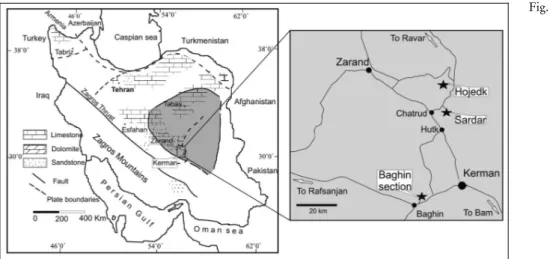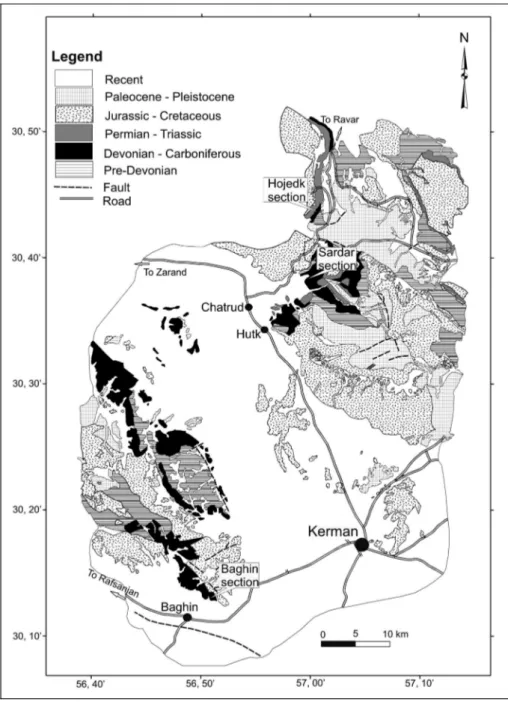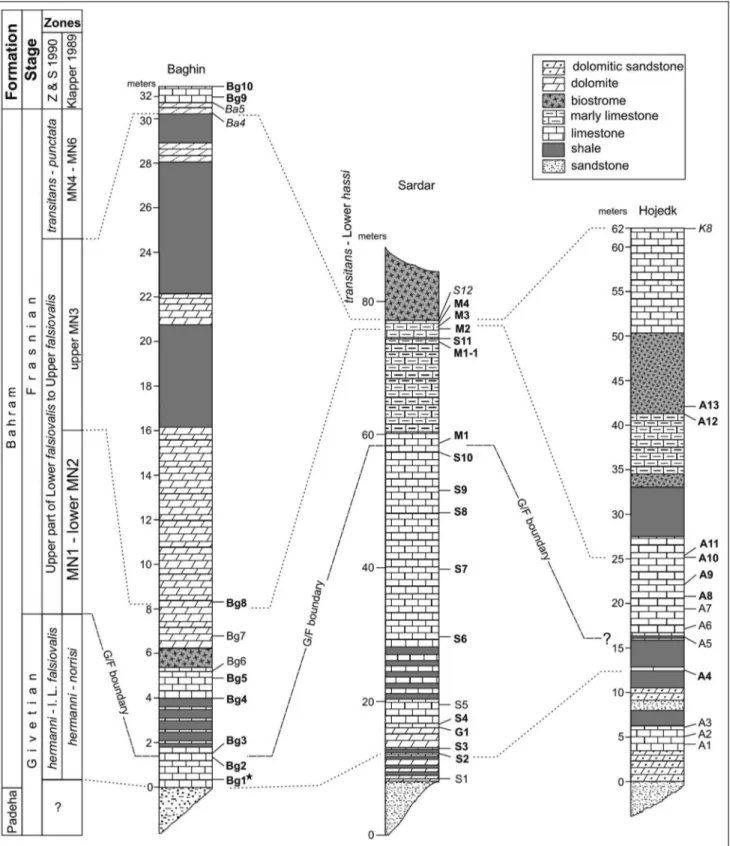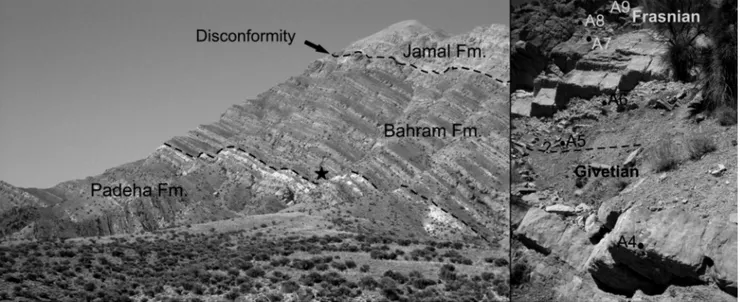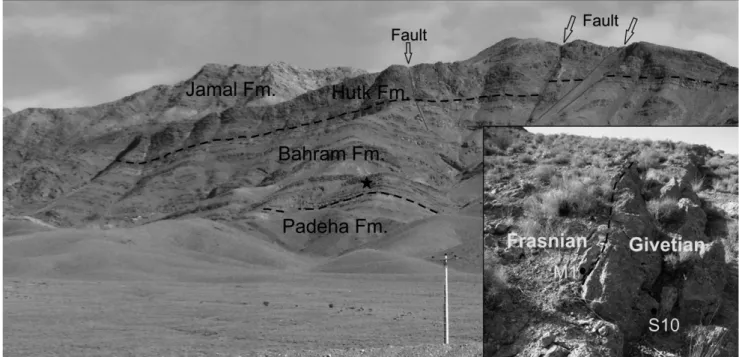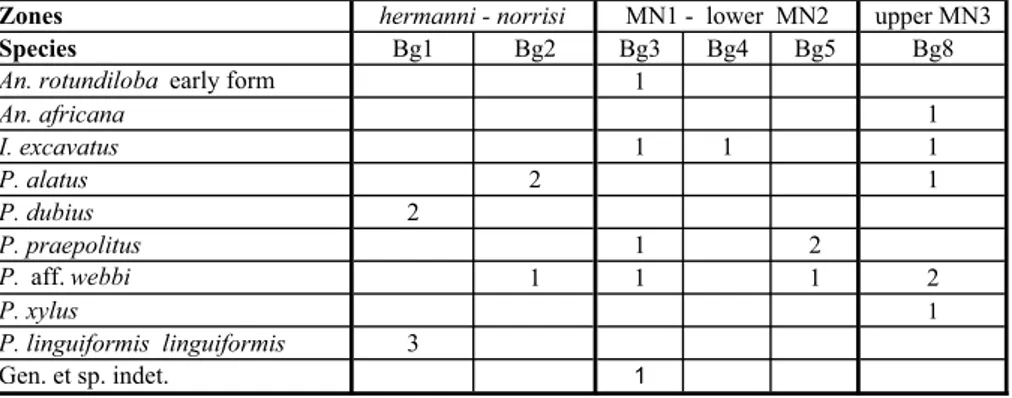GIVETIAN-FRASNIAN BOUNDARY CONODONTS FROM KERMAN PROVINCE,
CENTRAL IRAN
HOSSEIN GHOLAMALIAN1, VACHIK HAIRAPETIAN2, NAHID BARFEHEI3, SOHEYLA MANGELIAN4& PARVANEH FARIDI5
Received: April 12, 2012; accepted: May 21st, 2013
Key words: Iran, Devonian, Givetian - Frasnian boundary, con-odonts, biostratigraphy.
Abstract. The Middle - Late Devonian boundary is investigated based on twenty-two conodont species and subspecies from three sec-tions in the north and west of Kerman, southeastern central Iran. Upper Givetian - lower Frasnian carbonates of the basal part of the Bahram Formation transgressively overlie the sandstone beds of the top of (?) Early - Middle Devonian Padeha Formation. These massive ske-letal limestones encompass the G-F boundary. The base of Frasnian is identified by the appearance of early forms of Ancyrodella rotundiloba. It helps to compare our biozones to those of global stratotype in south-ern France. A new species, Polygnathus hojedki n. sp. is described here. New range is suggested for P. praepolitus.
Riassunto. Il limite Devoniano Medio - Devoniano Superiore viene studiato sulla base di 22 specie e sottospecie di conodonti ottenute da tre sezioni stratigrafiche situate a nord e a ovest di of Kerman, nell'Iran centrale, parte sudorientale. I carbonati di etaÁ tardo Givetiano-Frasniano basale, riferibili alla parte basale della Formazione Bahram ricoprono in discordanza i livelli arenacei sommitali della Formazione Padeha di etaÁ (?)Devoniano Inferiore - Medio. Questi calcari bioclastici massicci contengono il limite G-F. La base del Frasniano viene identi-ficata con la comparsa delle forme piuÁ primitive di Ancyrodella rotun-diloba. Questo fatto aiuta a confrontare le nostre biozone con quelle dello stratotipo globale nel sud della Francia. Viene descritta la nuova specie Polygnathus hojedki n. sp. E viene proposta una nuova distribu-zione per P. praepolitus.
Introduction
The Global Stratotype Section and Point (GSSP) of the Givetian - Frasnian boundary is located in the
Col du Puech de la Suque section E of Montagne Noire, southern France (Feist & Klapper 1985; Klapper et al. 1987). This boundary is designated at the base of bed 42a' in which early forms of Ancyrodella rotundiloba appear and mark the base of the Lower asymmetricus Zone, the base of Late Devonian in the scheme of Zieg-ler (1962) (Klapper 1985; Kirchgasser 1994). A few years later, Klapper (1989) and Ziegler & Sandberg (1990) presented separated new zonation schemes for the Late Devonian based on the pelagic genera. Klapper (1985; 2000); Feist & Klapper (1985) and Klapper et al. (1987) endorsed the SDS decision for the base of Fras-nian at the first occurrence of Ancyrodella rotundiloba. Whereas Sandberg et al. (1989) and Ziegler & Sandberg (1996; 2000) rejected the GSSP definition of the Give-tian - Frasnian boundary, by stating that ``Ancyrodella rotundiloba is a shallow water species with unknown ancestor''. Consequently they proposed to substitute the first occurrences of two other species, An. pristina and An. soluta (instead of An. rotundiloba) as biomar-kers for the base of Frasnian.
Despite the stratotype section in Montagne Noire, recent studies on the Middle - Late Devonian boundary have been performed in some regions in North Africa, Europe, North America and East Asia (Aboussalam & Becker 2007; Gouwy et al. 2007; Nar-kiewicz & Bultynck 2007). Miller (2007) studied the
1 Department of Geology, Faculty of Sciences, Hormozgan University, Po. Box 3995, Bandar Abbas, I.R. Iran. E-mail: [email protected]
2 Department of Geology, Islamic Azad University, Khorasgan (Esfahan) Branch, Esfahan, I.R. Iran. E-mail: [email protected] 3 Department of Geology, Islamic Azad University, Zarand Branch, Zarand (Kerman Province), I.R. Iran. E-mail: [email protected] 4 Department of Geology, Islamic Azad University, Zarand Branch, Zarand (Kerman Province), I.R. Iran.
E-mail: [email protected]
5 Department of Geology, Faculty of Sciences, Hormozgan University, Po. Box 3995, Bandar Abbas, I.R. Iran. E-mail: [email protected]
ontogenic lineage of some index conodont species in Sub-Polar areas of Russia. Devleeschouwer et al. (2010) have examined the parastratotype of the G-F boundary in Belgium by means of magnetic susceptibil-ity. Kirchgasser (1994) and Kralick (1994) analyzed the Ancyrodella species occurrence in some Middle - Late Devonian boundary successions of New York (USA). Hou et al. (1986) documented dacryconarids and con-odonts of the boundary interval in China. Until now, there was no precise diagnostic investigation on the Gi-vetian - Frasnian boundary interval in the Middle-East, except for some limited information from Iran such as Ashouri (2004, 2006).
In the present paper, we examined several cono-dont collections and their biostratigraphic implications on the exact position of the G-F boundary in the Ho-jedk, Baghin and Sardar localities in the North and West part of Kerman district, in the southeastern sector of East-Central Iran.
All of studied samples are stored in the Depart-ment of Geology, Faculty of Sciences, Hormozgan Uni-versity, Bandar Abbas.
Geographic position
The Hojedk section is located in 65 km North of Kerman, 4 km West of Heruz village (next to Kerman - Ravar road) at N30ë43'45.5@, E57ë00'54@ (Fig. 1). The base of Baghin section, 25 km west of Kerman (5 km northeast of Baghin city) is studied at: N30ë13'9.8@, E56ë51'7.7'' (Figs 1, 2). The Sardar section is located at N30ë38'8.77@, E56ë59'54.1@ in 45 km north of Ker-man. The best way to this section is a sidetrack that separates from the main road near the Khorasani cer-vix (Figs 1, 2).
Palaeogeography
East-central Iran microplate including its south-eastern sector, Kerman region, constituted a part of the
Peri-Gondawana shallow shelf margin in the Devonian (e.g. SengoÈr 1990; Stampfli 2000; Torsvik & Cocks 2004; Wendt et al. 2005; Muttoni et al. 2009). Biogeographic data on Late Devonian biotas (e.g. brachiopods, Brock & Yazdi 2000) in accordance with earlier data, display strong affinities to those on other neighbor Middle East-ern Peri-Gondwanan terranes at 30-45ëS palaeolatitude.
Stratigraphic setting
Four lithostratigraphic units have been recog-nized in the Devonian strata of central Iran: the Padeha, Sibzar, Bahram and Shishtu formations. Because of the very scarce palaeontological information, the age of the Padeha Formation is based on its stratigraphic position in the general succession and it is not well known in the most parts of Iran. StoÈcklin & Setudehnia (1991) placed this formation in the Early Devonian. Nasehi (1997) studied this formation in the Shabjereh section near Zar-and (Kerman Province) Zar-and based on conodonts, he attributed it to an Emsian - Givetian interval. The age of unfossiliferous dolostones of Sibzar Formation can only be estimated on the basis of its stratigraphic posi-tion in the all succession. This formaposi-tion is absent in the most parts of the Kerman area; such as Hojedk, Hutk, Baghin, Sardar sections and etc. In these areas, the Bah-ram Formation limestones directly cover the sandstones and shales of the Padeha Formation in the mentioned areas. So the Sibzar Formation dolostones seem to be the lateral equivalent of limestones of the lower part of the Bahram Formation in the most parts of Kerman area, except for the Gerik section (Wendt et al. 2002). Analysis of the Bahram Formation stratotype in Ozbak-Kuh (N Tabas) and its equivalent successions in the Esfahan and Kerman regions shows that this formation is diachronous. It is Eifelian in the Zefreh section in NE Esfahan (Brice et al. 2006), Givetian in the Soh section in N Esfahan (Adhamian 2003), late Givetian - early Fras-nian in the Ozbak-Kuh section (Khaksar et al. 2006),
Fig. 1 - Palaeogeographic map of Iran (redrawn from Wendt et al. 2005), showing the roads and locations of the studied sections in the Ker-man area, southeastern cen-tral Iran. The shaded area is the east-central Iran micro-plate.
late Givetian - early Famennian in the Hojedk section (Gholamalian & Kebriaei 2008) and late Frasnian - early Famennian in the Shams Abad section, W Kerman (Bahrami et al. 2011a). The boundary between the Bah-ram and the overlying Shishtu Formation is not de-scribed or cannot be easily observed in the most of sec-tions; so Wendt et al. (2002; 2005) would prefer to use the name of Bahram Formation for all of Middle to Late Devonian carbonate successions. Despite the recent works on the Late Devonian of central Iran, it seems that a comprehensive and precise conodont research on the Early to Middle Devonian deposits is really needed.
History of the G-F boundary studies in Iran
Among recent studies on central Iran, there are some papers on the Devonian strata e.g. Yazdi (1999),
Ashouri (2002), Gholamalian (2007), Gholamalian et al. (2009), Bahrami et al. (2011a, 2011b); but only a few of authors refer to the Middle Devonian (Adhamian 2003; Brice et al. 2006; Wendt et al. 2002, 2005). The G-F boundary was studied by Ashouri (2004, 2006) who identified it in the bed S241 in the middle part of the Member 3 of the Khoshyeilaq Formation (Eastern Al-borz, northern Iran) on the basis of presence of Ancy-rodella pristina and An. binodosa. Wendt et al. (2002; 2005) recognized this boundary in the lower part of the Bahram Formation in several sections of Central Iran (e.g. Howz-e-dorah, Anarak, Hutk, Hojedk and Gerik), and in the Khoshyeilaq Formation in northern Iran (Khoshyeilaq and Mighan). Identification was gen-erally based on scarce paleontological data from poor conodont samples.
Fig. 2 - Simplified geological map of Kerman area (compiled from Sahandy 1991 and Zohreh-bakhsh et al. 1992).
Studied successions
Hojedk section (Figs 3, 4)
Conodont biostratigraphy and lithology of the Bahram Formation succession in the Hojedk area were described by Gholamalian & Kebriaei (2008). The
low-ermost part of this section is reassessed in this work for a more precise positioning of G-F boundary. The base of the measured succession begins with 3.4 m of dolo-mitic sandstone above the top of the Padeha Formation and continues by 2.75 m thin bedded limestone and 13.85 m shale, sandstone, dolomite and nodular
lime-Fig. 3 - Lithostratigraphic columns with localization of the investigated samples and correlation of the G-F boundary studied successions in the Kerman Province, SE Iran. l.-L. falsiovalis = lower part of Lower falsiovalis.$B1 - hermanni Zone. Productive samples are shown in bold, and italic ones are studied by Gholamalian et al. (2011) and Gholamalian & Kebriaei (2008).
stone. The overlying 11.15 m red to grey massive skele-tal packstone contains abundant brachiopod shells. The sequence continues upwards with limestones, shales and sandstones (mostly in the lower half of the section). Two biostromes (rugose and tabulate corals and bryozoa) occur here. Gholamalian & Kebriaei (2008, p. 175) thor-oughly discussed the age of these diachronic biostromes in the Kerman area and other parts of central Iran.
Baghinsection(Figs 3, 5)
This section consists of 102.5 meters of shale, lime-stone and sandlime-stone; and was recently studied by Gho-lamalian et al. (2011). The lowermost quartzarenite (16.8
m) of the top of Padeha Formation is conformably cov-ered by a 1.8 m of thin bedded skeletal limestone defining the base of the Bahram Formation. These beds are over-lain by 1.35 m of medium bedded skeletal limestones. A coral bed of 0.85 m thick underlies 24.5 m of early Fras-nian dolostones and shales (Gholamalian et al. 2011). The rest of the succession is mostly composed of middle to late Frasnian medium and thick bedded limestones.
Sardar section (Figs 3, 6)
The carbonates of the basal part of the Bahram Formation transgressively overlie 5.4 m key quartzar-enite of the Padeha Formation. The contact between
Fig. 4 - General view of the Hojedk section with close up of G-F boundary. Asterisk shows the sampled interval.
the Padeha and Bahram formations is obviously sharp and the Sibzar Dolomite Formation is missing in this area. The base of the Bahram Formation begins with a 3.6 m alternation of dolostones and shales and con-tinues with 15.8 m of thin bedded limestone, dolostone and an alternation of limestone and shale. A thickness of 32 m of thin bedded limestones and 16.4 m marly limestones overlie the mentioned beds. These beds un-derlie a coral and bryozoan dominated biostrome reef. The top of the Bahram Formation is referred to the Famennian (Molaahmadi et al. 2012). It is disconform-ably overlain by the Early Carboniferous grey lime-stones and massive dololime-stones of the Hutk Formation (Molaahmadi et al. 2012).
Biostratigraphy
This work is based on 28 productive out of 39 acid-leached samples taken from three sections (Tabs 1-3). Positions of these samples are shown on the Fig. 3. Six samples: Ba4, Ba5, Bg9, Bg10 (Baghin section), K8 (Hojedk section) and S12 (Sardar section) belong to the MN4 Zone (transitans Zone) or are even younger ac-cording to earlier studies (Gholamalian & Kebriaei 2008; Gholamalian et al. 2011). Twenty-two species and subspecies belonging to five genera enabled us to use the global zonations of Klapper (1989), Klapper & Johnson (1990) and Ziegler & Sandberg (1990) (in some cases). The presence of the early form of An.
rotundi-Fig. 6 - General view and close up of G-F boundary in the Sardar section. Asterisk shows the sampled interval.
Zones hermannilower MN1
-Species Sample A4 A8 A9 A10 A11 A12 A13
An. rotundiloba early form 9 25 4
An. africana 1 1 An. binodosa 6 6 1 I. aff. subterminus 5 12 1 6 1 I. excavatus 6 5 16 14 I. xenium 1 I. sp. 2 P. praepolitus 6 P. hojedki n. sp. 1 2 1 4 P.aff. dubius 24 P. dubius 50 2 6 3 1 P. alatus 2 1 5 3 5 1 P.aff. xylus 127 6 3 11 P. denisbriceae 1 P. pollocki 1 P. sp. A 1 P. sp. B 1 T. aff. weddigei 4
upper MN1 - upper MN2 upper MN3 Tab. 1 - Range chart of conodonts inthe Hojedk section; L. = Lower, U. = Upper, herm. = hermanni, fals. = falsiovalis.
loba, the index species for the base of the Late Devonian is an important discovery that allows us to correlate our biozones with those of the GSSP in the Montagne Noire, France (Fig. 3). Abbreviations used here are: An. = Ancyrodella, T. = Tortodus, I. = Icriodus, P. = Polygnathus, Schm. = Schmidtognathus.
Hojedk section
* hermanni - lower MN1 zones (A4 to A7):
The age of this interval is based on the first ap-pearance of Polygnathus dubius that first occurs at the base of the Lower hermanni Zone (Narkiewicz & Bul-tynck 2010) and the age of the next interval (upper MN1 - MN2).
Other associated species are: Polygnathus alatus, P. aff. dubius, P. aff. xylus, P. hojedki n. sp., Icriodus excavatus and I. aff. subterminus.
Polygnathus alatus that was assumed to be re-stricted to the Frasnian, is recently reported from the ansatus Zone (Klapper & Johnson 1980, Tab. 10; Nar-kiewicz & Bultynck 2007).
* Upper MN1- upper MN2 zones (A8 - A10)
This interval is characterized by the total range of Ancyrodella binodosa (Narkiewicz & Bultynck,
2010). The presence of Ancyrodella rotundiloba early form is also important here, being the index for the base of Frasnian (Klapper et al. 1987; Klapper 1985, 1989).
Other associated species are: Polygnathus prae-politus, P. alatus, P. hojedki n. sp., P. dubius, P. denis-briceae, P. pollocki, P. sp. A, P. sp. B, Icriodus vitabilis, I. xenium, I. excavatus, I. sp., and Tortodus aff. wed-digei.
Polygnathus praepolitus that had previously known from Upper falsiovalis - Lower rhenana zones (MN3 - MN11) (Ovnatanova & Kononova 2001, 2008), appears in this interval, so we suggest new range; MN1-MN11.
* Upper MN3 Zone (A11-A13)
The base of this interval is defined by the first appearance of An. africana ranging from the upper MN3 to MN6 zones. The top is limited by the pre-sence of P. aequalis in the sample K8 (see Gholamalian & Kebriaei 2008). According to Ji & Ziegler (1993), this species appears at the base of transitans Zone (MN4).
Other associated species are: Icriodus aff. subter-minus, P. alatus, P. dubius.
Zones upper MN3
Species Bg1 Bg2 Bg3 Bg4 Bg5 Bg8
An. rotundiloba early form 1
An. africana 1 I. excavatus 1 1 1 P. alatus 2 1 P. dubius 2 P. praepolitus 1 2 P. aff. webbi 1 1 1 2 P. xylus 1 P. linguiformis linguiformis 3 Gen. et sp. indet. 1 MN1 - lower MN2 hermanni - norrisi
Tab. 2 - Range chart of conodonts in the Baghin section; the age of sample Bg1 is hermanni Zone.
Zones
Species S2 S3 G1 S4 S6 S7 S8 S9 S10 M1 M1-1 S11 M2 M3 M4
An. rotundiloba early form 1 3
An. africana 1 An. binodosa 1 I. aff. subterminus 3 29 6 4 13 4 8 14 22 30 2 2 I. excavatus 3 1 2 35 2 15 7 4 P. praepolitus 8 19 6 1 10 P.aff. webbi 2 7 6 6 8 P. hojedki n. sp. 1 1 P.aff. dubius 2 2 1 P. dubius 2 1 1 2 P. alatus 7 10 5 5 37 34 27 1 8 5 P. xylus 5 24 24 4 9 11 11 6 11 10 6 P. denisbriceae 1 P. sp. A 3 4 P. sp. B 2 P.sp. C 1 T. aff. weddigei 1
hermannito norrisi MN1 - lower MN2 upper MN3
Sardar section
* hermanni - norrisi zones (S2-S10)
The base and top of this interval are recognized due to presence of P. dubius and the age of the next interval (MN1 - MN2).
Other associated species are: Polygnathus alatus, P. dubius, P. aff. dubius, P. aff. webbi, P. xylus, P. denis-briceae, P. hojedki n. sp., P. sp. A, Tortodus aff. weddi-gei, Icriodus excavatus and I. aff. subterminus.
* MN1 - lower MN2 zones (samples M1 - M2)
The age of the interval is based on the first occur-rence of Ancyrodella rotundiloba early form in sample M1 (Tab. 3).
Other associated species are: Ancyrodella binodo-sa, Polygnathus alatus, P. dubius, P. aff. dubius, P. aff. webbi, P. praepolitus, P. xylus, Icriodus excavatus and I. aff. subterminus.
* Upper MN3 Zone
The lower limit can be defined by the entrance of Ancyrodella africana, the top by the first appearance of P. aequalis in the sample S12 (Gholamalian et al. in prep.). Other associated species are: P. praepolitus, P. aff. webbi, P. alatus, I. aff. subterminus.
Baghinsection
* hermanni - norrisi zones (Bg1 and Bg2)
The age of hermanni Zone for sample Bg1 is proved, based on the first appearance of P. dubius and the last occurrence of P. linguiformis linguiformis (Nar-kiewicz and Bultynck 2007: 425-427, 2010). The age of sample Bg2 with no index species is hermanni - norrisi zones on the basis of its stratigraphic position.
* MN1 - lower MN2 zones (Bg3)
The base of this interval is recognized by the first appearance of An. rotundiloba early form. The top is coincident with the base of the next zone.
Other associated species are: Polygnathus praepo-litus, P. aff. webbi and Icriodus excavatus.
* Upper MN3 Zone (Bg8)
The lower limit of this zone is indicated by the entrance of An. africana; the upper one by the presence of P. aequalis at the base of the next zone in the sample Ba4 (Gholamalian et al. 2011).
Systematic palaeontology
Order Ozarkodinida Dzik, 1976 Family Polygnathidae Bassler, 1925
Genus Polygnathus Hinde, 1879 Type species: Polygnathus dubius Hinde, 1879
Polygnathus hojedkin. sp. Pl. 3, Figs 8-13
Holotype: HUIC532, sample A4, Hojedk section, Pl. 3, Figs 10-12.
Paratype: HUIC530, sample A10, Hojedk section, Pl. 3, Figs 8-9.
Material: One specimens from sample A4, 2 from A8, 1 from A9, 4 from A10 (Hojedk section); one from S3 and 1 from M1-1 (Sardar section).
Etymology: This species is named after the Hojedk village where the first specimens were found.
Diagnosis: This polygnathid species is characterized by an asymmetric platform with nodes that are arranged in short transverse ridges and a high carina reaching the posterior end. Adcarinal troughs are deep and extend to the platform posterior end. The inner margin of platform is straight and parallel to the carina. The outer part of the platform is triangular. Its outer margin is straight and longer from the anterior geniculation point to the angle of refraction, that is rounded and straight to slightly concave and shorter from the angle to the posterior end.
Description. This species is characterized by an asymmetric triangular platform. The platform is con-stricted in the anterior part, widest in the middle part, and progressively narrowing in the posterior part. The posterior end is semi-rounded to weekly sharp. Coarse separate nodes are arranged in longitudinal rows. These nodes can be connected forming short transversal ridges which do not reach the carina. The high carina reaches the posterior end. It is smooth in the anterior half and is composed of separate denticles in the posterior half. Adcarinal troughs are deep and extend to the posterior end. The free blade is composed of 9 to 10 isometric denticles and equal to one third of the total length of the unit. A small basal cavity is located beneath the anterior third of the platform. The keel is distinct.
Remarks. Polygnathus hojedki can be distin-guished from P. webbi by having longitudinal rows of nodes in addition to short transversal ridges. Other re-cently defined species, Polygnathus vachiki Gholama-lian, can be recognized from P. hojedki by complete lack of longitudinal rows of nodes and disappearance of deep adcarinal troughs in the mid-platform. Poygnathus ho-jedki can be discriminated from P. nodocostatus by hav-ing transversal ridges on the surface and deeper adcar-inal troughs and from P. strictus by separated denticles on the anterior half of platform, shorter blade and very short adcarinal troughs.
Range. hermanni - upper MN2 zones, according to associated species (Tabs 1, 3).
Conclusions
The presence of the early form of Ancyrodella rotundiloba as key biomarker for the base of Late De-vonian enabled us to define the G-F boundary in south-east Iran and correlate it to the GSSP in Montagne Noire (France). The following biozones are recognized: hermanni; hermanni - norrisi; MN1 - MN2; and MN3. In all studied sections, characterized by shallow marine faunas, the base of Bahram Formation belongs to a late Givetian - early Frasnian time interval. A new late
Gi-vetian - early Frasnian conodont species, Polygnathus hojedki n. sp. is described. A new range, from MN1 to MN11 (Ovnatanova & Kononova 2008) zones is pro-posed for P. praepolitus.
Acknowledgements. Authors are grateful for all helps from Prof. G. Klapper (USA) who provided useful comments on primary identification of polygnathid and ancyrodellid species. Authors express
sincerely gratitude to Drs. K. Narkiewics and S. Gouwy for their cri-tical comments on the early version of paper. We thank Dr. M.J. Has-sani, I. Torkzadeh (High Technology Education University of Ker-man), Dr. A. Bahrami, (Esfahan University), M. Momeni (Islamic Azad University, Zarand Branch) and Z. Khosravi (Damghan University) for their useful helps in technical supports and field works. Dr. Khodaei (Islamic Azad University, Majlesi Branch, Esfahan) is appreciated for providing SEM micrographs.
R E F E R E N C E S
Aboussalam Z.S. & Becker R. T. (2007) - New Upper Gi-vetian to basal Frasnian conodont faunas from the Tafilalt (Anti-Atlas, Southern Morocco). Geol. Quart., 51(4): 345-374.
Adhamian A. (2003) - Middle Devonian (Givetian) cono-dont biostratigraphy in the Soh area, north of Esfa-han, Iran. Cour. Forsch-Inst. Sencken., 245: 183-193. Ashouri A.R. (2002) - Palmatolepis (Conodonta; Late
De-vonian) from Tabas region, eastern Iran. Iran. Int. J. Sci., 3: 187-220.
Ashouri A.R. (2004) - Late Devonian and Middle - Late Devonian conodont from eastern and northern Iran. Riv. Esp. Micropaleont., 36: 355-365.
Ashouri A.R. (2006) - Middle Devonian - Early Carbonifer-ous conodont faunas from the Khoshyeilagh Forma-tion, Alborz Mountains, North Iran. J. Sci., Is. Rep. Ir., 17(1): 53-65.
Bahrami A., Gholamalian H., Corradini C. & Yazdi M. (2011a) - Upper Devonian conodont biostratigraphy of Shams-Abad section, Kerman Province, Iran. Riv. It. Paleont. Strat., 117(2): 199-209.
Bahrami A., Corradini C. & Yazdi M. (2011b) - Upper De-vonian - Lower Carboniferous conodont biostratigra-phy in the Shotori Range, Tabas area, central-east Iran Microplate. Boll. Soc. Paleont. It., 50(1): 35-53. Brice D., Yazdi M., Torabi H. & Maleki A. (2006) -
Devo-nian brachiopods from the Zefreh section (Central Iran). Ann. Soc. GeÂol. Nord,13: 141-155.
Brock G.A. & Yazdi M. (2000) - Palaeobiogeographic affi-nities of Late Devonian brachiopods from Iran. Rec. West. Aust. Mus., Supp., 58: 321-334.
Devleeschouwer X., Petitclerc E., Spassov S. & Preat A. (2010) - The Givetian - Frasnian boundary at Nismes parastratotype (Belgium): the magnetic susceptibility signal controlled by ferromagnetic minerals. Geol. Belg., 13(4): 351-366.
Feist R. & Klapper G. (1985) - Stratigraphy and conodonts in pelagic sequences across the Middle - Upper De-vonian boundary, Montagne Noire, France. Palaeon-tologr. Abt. A., 188(1/3): 1-18.
Gholamalian H. (2007) - Conodont biostratigraphy of the Frasnian-Famennian boundary in the Esfahan and Ta-bas areas, Central Iran. Geol. Quar., 51(4): 453-476. Gholamalian H. & Kebriaei M.R. (2008) - Late Devonian
conodonts from Hojedk section, Kerman province,
southeastern Iran. Riv. It. Paleont. Strat., 114(2): 171-181.
Gholamalian H., Ghorbani M. & Sajadi S.H. (2009) - Fa-mennian conodonts from Kal-e-Sardar section, east-ern Tabas, Central Iran. Riv. It. Paleont. Strat., 115(2): 141-158.
Gholamalian H., Hosseini-Nezhad S.M., Khosravi Z. & Turkzadeh-Mahani I. (2011) - Late Devonian cono-donts from Baghin section, West of Kerman. Geosci. Quart. J., 21(81): 165-172, (in Persian with English abstract), Tehran.
Gouwy S., Haydukiewicz J. & Bultynck P. (2007) - Conodontbased graphic correlation of upper Givetian -Frasnian sections of the Eastern Anti-Atlas (Moroc-co). Geol. Quart., 51(4): 375-392.
Hou H.F., Ji Q., Xian S.Y. & Wang J.X. (1986) - Middle ± Upper Devonian boundary in Maanshan of Xiangz-hou, Guangxi. Pub. House, 138 pp., Beijing.
Ji Q. & Ziegler W. (1993) - The Lali section: an excellent reference section for Late Devonian in south China. Cour. Forsch-Inst. Sencken., 157: 183 pp.
Khaksar K., Bahari R. & Ashouri A.R. (2006) - Devonian Rugose corals from Bahram Formation, South of Oz-bak-Kuh (Iran). Geosci. Quart. J., 15(59): 56-69, (in Persian with English abstract).
Kirchgasser W.T. (1994) - Early morphotypes of Ancyrodella rotundiloba at the Middle - Upper Devonian bound-ary, Genesee Formation west-central New York. Stud. Strat. Paleont. Bull., 481: 117-134.
Klapper G. (1985) - Sequence in conodont genus Ancyrodel-la in Lower asymmetricus Zone (earliest Frasnian, Upper Devonian) of the Montagne Noire, France. Palaeontogr. Abt. A., 188(1/3): 19-34.
Klapper G. (1989) - The Montagne Noire Frasnian (Upper Devonian) conodont succession. In: N.J. McMillan, A.F. Embry and D.G. Glass (Eds) - Proceedings of the Second International Symposium on the Devo-nian System. Can. Soc. Petrol. Geol., 3: 449-468. Klapper G. (2000) - Species of Spathognathodontidae and
Polygnathidae (Conodonta) in the recognition of Upper Devonian stage boundaries. Cour. Forsch-Inst. Sencken., 220: 153-159.
Klapper G., Feist R. & House M. (1987) - Decision on boundary stratotype for the Middle/Upper Devonian series boundary. Episodes, 10(2): 97-101.
Klapper G. & Johnson J. G. (1980) - Endemism and disper-sal of Devonian conodonts. J. Paleont., 54: 400-455. Klapper G. & Johnson J.G. (1990) - Revisions of Middle
Devonian conodont zones. In: J.G. Johnson (Ed.) ± Lower and Middle Devonian brachiopod-dominated communities of Nevada, and their position in a bio-facies-province-realm model. J. Paleont., 64(6): 934-941.
Kralick J.A. (1994) - The conodont genus Ancyrodella in the Middle Genesee Formation (Lower Upper Frasnian), western New York. J. Paleont., 68(6): 1384-1395. Miller C.G. (2007) - Growth in early species of the
cono-dont Ancyrodella and implications for correlation of the Middle - Upper Devonian boundary. Geol. Quart., 51(4): 443-452.
Molaahmadi M., Dastanpour M., Lotf-Abad Arab A., As-ghari L. & Mazhab-Jafari M. (2012) - Study of Early Carboniferous crinoids in Sardar Section, (North of Kerman). Proceeding of 30th Geosciences Congress,
Geological Survey of Iran, February 19-21, 2012, 1-7. Muttoni G., Mattei M., Balini M., Zanchi A., Gaetani M. & Berra F. (2009) - The drift history of Iran from the Ordovician to the Triassic. In: Brunet M.-F., Wilmsen M. & J. W. Granath (Eds) - South Caspian to Central Iran Basins. Geol. Soc. London, Spec. Pub., 312: 7-29. Narkiewicz K. & Bultynck P. (2007) - Conodont biostrati-graphy of shallow marine Givetian deposits from the Radom ± Lublin area, SE Poland. Geol. Quart., 51(4): 419-442.
Narkiewicz K. & Bultynck P. (2010) - The Upper Givetian (Middle Devonian) subterminus conodont zones in North America, Europe and North Africa. J. Paleont., 84(4): 588-625.
Nasehi E. (1997) - Early to Middle Devonian conodonts from Central Iran. Geosci. Quart. J., 6: 78-87. Ovnatanova N.S. & Kononova L.I. (2001) - Conodonts and
Late Devonian (Frasnian) biostratigraphy of central regions of Russian platform. Cour. Forsch-Inst. Senck-en., 233, 115 pp.
Ovnatanova N.S. & Kononova L.I. (2008) - Frasnian con-odonts from the Eastern Russian Platform. Paleont. Zhour., 42(10): 997-1166.
Sahandy M. R. (1991) - Geological map of Kerman (1/ 250000), part A. Geol. Surv. Ir., sheet J10.
Sandberg C.A., Ziegler W. & Bultynck P. (1989) - New standard conodont zones and early Ancyrodella
phy-logeny across Middle-Upper Devonian boundary. Cour. Forsch.-Inst. Sencken., 110: 195-230.
SengoÈr A. M. C. (1990) - A new model for the Late Palaeo-zoic-Mesozoic tectonic evolution of Iran and implica-tions for Oman. In: Robertson A. H. F., Searle M. P. & Ries A. C. (Eds) - The Geology and Tectonics of the Oman Region. Geol. Soc. London., Sp. Pub., 49: 797-831.
Stampfli G. M. (2000) - Tethyan oceans. In: Bozkurt E., Winchester J. A. & J. D. Piper (Eds) - Tectonics and Magmatism in Turkey and the Surrounding Area. Geol. Soc. London, Sp. Pub., 173: 1-23.
StoÈcklin J. & Setudehnia A. (1991) - Stratigraphic Lexicon of Iran. Geol. Sur. Ir. Rep. 18, 376 pp.
Torsvik T.H. & Cocks L.R.M. (2004) - Earth geography from 400 to 250 Ma: a palaeomagnetic, faunal and facies review. J. Geol. Soc. London, 161: 555-572. Wendt J., Kaufmann B., Belka Z., Farsan N. & Karimi
Ba-vandpour A. (2002) - Devonian/Lower Carboniferous stratigraphy, facies patterns and palaeogeography of Iran, part I, southeastern Iran. Acta Geol. Pol., 52(2): 129-168.
Wendt J., Kaufmann B., Belka Z., Farsan N. & Karimi Ba-vandpour A. (2005) - Devonian/Lower Carboniferous stratigraphy, facies patterns and palaeogeography of Iran, part II, northern and central Iran. Acta Geol. Pol., 55(1): 31-97.
Yazdi M. (1999) - Late Devonian - Carboniferous conodonts from eastern Iran. Riv. It. Paleont. Strat., 105(2): 167-195.
Ziegler W. (1962) - Taxionomie und phylogenie ober devo-nischer conodonten und ihre stratigraphische bedeu-tung. Abh. Hess. Landes. Bodenf., 38, 166 pp. Ziegler W. & Sandberg C.A. (1990) - Late Devonian
stan-dard conodont zonation. Cour. Forsch.-Inst. Sencken., 121, 115 pp.
Ziegler W. & Sandberg C.A. (1996) - Reflexions on Frasnian and Famennian Stage boundary decisions as a guide to future deliberations. Newsl. Strat., 33: 157-180. Ziegler W. & Sandberg C.A. (2000) - Utility of
palmatole-pids and icriodontids in recognizing Upper Devonian series, stages and possible substage boundaries. Cour. Forsch.-Inst. Sencken., 225: 335-437.
Zohrehbakhsh A., Vahdati-Daneshmand F., Djokovic I. & Dimitrijevic M.N. (1992) - Geological map of Rafsan-jan 1/250000, parts A & D. Geol. Surv. Ir., sheet I-10.
PLATE 1
Figs 1-2 - Ancyrodella rotundiloba (Bryant, 1921) early form, HUIC418, sample S11, Sardar section, x 30.
Figs. 3-4 - Ancyrodella rotundiloba (Bryant, 1921) early form, HUIC461, sample A9, Hojedk section, upper and lower views, x 30.
Fig. 5 - Ancyrodella rotundiloba (Bryant, 1921) early form, HUIC463, sample A9, Hojedk section, upper view, x 30. Figs 6-7 - Ancyrodella rotundiloba (Bryant, 1921) early form, HUIC465, sample A9, Hojedk section, upper and lower views, x 41.
Figs 8-9 - Ancyrodella rotundiloba (Bryant, 1921) early form, HUIC468, sample A8, Hojedk section, upper view, x 31. Figs 10-11 - Ancyrodella rotundiloba (Bryant, 1921) early form, HUIC472, sample A8, Hojedk section, upper and lower views, x 34.
Figs 12-13 - Ancyrodella rotundiloba (Bryant, 1921) early form, HUIC480, sample A9, Hojedk section, upper and lower views, x 35.
Figs 14-15 - Ancyrodella binodosa Uyeno, 1967, HUIC474, sample A8, Hojedk section, upper and lower views, x 53. Figs 16-17 - Ancyrodella binodosa Uyeno, 1967, HUIC478, sample
A9, Hojedk section, upper and lower views, x 45. Figs 18-19 - Ancyrodella binodosa Uyeno, 1967, HUIC482, sample
A9 Hojedk section, upper and lower views, x 31. Figs 20-21 - Ancyrodella africana GarcõÂa-LoÂpez, 1981, HUIC484,
sample A11, Hojedk section, upper and lower views, x 44.
PLATE 2
Figs 1 - Gen. et sp. indet., HUIC560, sample Bg3, Baghin section, upper view, x 30.
Figs 2, 4, 6-8 - Icriodus excavatus Weddige, 1984. 2) HUIC486 sam-ple A4, Hojedk section, upper view, x 49; 4) HUIC487 sample A8, Hojedk section, upper view, x 61; 6) HUIC490, sample A9, Hojedk section, upper view, x 60; 7) HUIC488 sample A10, Hojedk section, upper view, x 48; 8) HUIC547, sample M1-1, Sardar section, upper view, x 51.
Figs 3 - Icriodus aff. subterminus Youngquist, 1947, HUIC542, sample S3, Sardar section, upper view, x 61.
Fig. 5 - Icriodus xenium Nazarova, 1997, HUIC489, sample A9, Hojedk section, upper view, x 47.
Fig. 9 - Icriodus sp. HUIC491, sample A8, Hojedk section, upper view, x 53.
Figs 10-13, 15 - Polygnathus aff. dubius Hinde, 1879. 10-11) HUIC492, sample A4, Hojedk section, upper and lateral views, x 45; 12-13) HUIC511, sample A4, Ho-jedk section, upper and lower views, x 30; 15) HUIC512, sample A4, Hojedk section, upper view, x 42.
Figs 14, 16-17 - Polygnathus dubius Hinde, 1879. 14) HUIC515, sample A4, Hojedk section, upper view, x 31; 16-17) HUIC503, sample A4, Hojedk section, upper and lower views, x 40.
Fig. 18 - Polygnaths pollocki Druce, 1976, HUIC507, sample A10, Hojedk section, upper view, x 36.
Figs. 19-22 - Polygnaths aff. xylus Stauffer, 1940. 19) HUIC500 sample A4, Hojedk section, upper view, x 49; 20-21) HUIC575, sample S3, Sardar section, upper and lower views, x 50; 22) HUIC576, sample A4, Hojedk section, upper view, x 48.
Figs 23-26 - Polygnathus alatus Huddle, 1934. 23) HUIC571, sample M1, Sardar section, upper view, Sardar sec-tion, upper view, x30; 24) HUIC559, sample M2, Sardar section, upper view, x 35; 25) HUIC577, sam-ple M1-1, Sardar section, upper view, x 33; 26) HUIC578, sample M1, Sardar section, upper view, x 31.
PLATE 3
Figs 1, 2, 6, 7- Polygnathus praepolitus Kononova, Alekseev, Barskov and Reimers, 1996. 1) HUIC550, sample M1-1, Sardar section, upper view, x 43; 2) HUIC551, sample M1-1, Sardar section, upper view, x 56; 6) HUIC552, sample S11, Sardar section, upper view, x 52; 7) HUIC525, Sample A11, hojedk section, upper view, x 52. Figs 3-5 - Polygnathus alatus Huddle 1934. 3) HUIC555, sample
S9, Sardar section, upper view, x 40; 4) HUIC561, sample Bg8, Baghin section, upper view, x 40; 5) HUIC553, sample S8, upper view, x 38.
Figs 8-13 - Polygnathus hojedki n. sp. 8-9) HUIC530, sample A10, Hojedk section, upper and lower views, x 40; 10-12) HUIC532, sample A4, Hojedk section, upper, lower and lateral views, x 35; 13) HUIC574, sample S3, Sardar section, upper view, x 33.
Fig. 14 - Polygnathus sp. C, HUIC562, sample M1-1, Sardar section, upper view, x 40.
Figs 15-16 - Polygnathus alatus Huddle, 1934, HUIC498, sample A4, Hojedk section, upper and lower views, x 33. Figs 17-18 - Polygnathus aff. webbi Branson & Mehl, 1934, 17)
HUIC563, sample M1-1, Sardar section, upper view, x 40; 18) HUIC564, sample M1-1, Sardar section, upper view, x 40.
Fig. 19 - Polygnathus linguiformis linguiformis Hinde, 1879, HUIC565, Sample Bg1, Baghin section, upper view, x 35.
Fig. 20 - Polygnathus sp. A, HUIC534, sample A9, Hojedk sec-tion, upper view, x 32.
Fig. 21 - Polygnathus denisbriceae Bultynck, 1979, HUIC535, sample A9, Hojedk section, upper view, x 45. Figs 22-26 - Tortodus aff. weddigei Aboussalam, 2003. 22)
HUIC536, sample A10, Hojedk section, upper view, x 39; 23-24) HUIC537, sample A10, Hojedk section, upper and lateral views, x 40; 25-26) HUIC538, sample A10, Hojedk section, upper and lower views, x 33.
